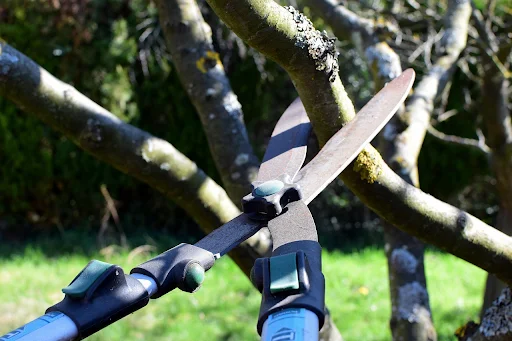Want to maintain the trees in your yard and keep them healthy and looking great?
Tree pruning isn’t just about making your yard look nice. It’s about protecting your home and property value, and ensuring the safety of your family and neighborhood. Trees that are properly trimmed and cared for add 3-15% to property values, according to the Arbor Day Foundation.
Here’s the problem:
The typical homeowner isn’t sure when to prune their trees or how to do it right. They either ignore their trees until there’s a problem, or they hack away at branches without understanding what they’re doing.
The good news? Tree pruning is easy to learn and doesn’t need to be difficult. Most basic tree care can be done by anyone with the right tools and know-how. And if a task is beyond your abilities, knowing the cost of trimming trees ahead of time helps you plan for hiring a home improvement contractor when needed.
Here’s your guide:
- Why Tree Pruning Is Important
- When to Prune Your Trees
- Essential Pruning Techniques Every Homeowner Should Know
- Common Pruning Mistakes to Avoid
- Safety Tips for DIY Tree Pruning
Why Tree Pruning Is Important
Tree pruning is one of those home improvement tasks that people tend to ignore until it’s too late.
But regular pruning does more than just keep your yard looking tidy. Dead or dying branches can fall during storms and cause serious damage to your roof, vehicles, and power lines. Pruning removes that risk.
And here’s something most people don’t realize…
Homeowner insurance only covers up to 5% of dwelling coverage for tree and landscaping damage, according to III.org. If a neglected tree falls on your house, the insurance payout may not cover the full repair cost.
Pruning also makes trees grow healthier and more vigorously. By removing dead or damaged branches, the tree can put more energy into producing new, stronger limbs with lusher foliage. This makes it more resistant to pests, disease, and inclement weather.
Remember this analogy — would anyone skip regular maintenance on their car and expect it to run perfectly? Trees are the same way. They need regular care and attention to thrive.
When to Prune Your Trees
Timing is everything when it comes to pruning your trees.
Most trees do best when pruned during their dormant season. This is usually late winter or early spring, before the start of new growth. Pruning at the right time of year reduces stress on the tree and helps prevent disease transmission.
Exceptions to this rule exist for some trees. Each species has a specific window of time that works best for pruning:
- Spring-flowering trees should be pruned immediately after they flower
- Summer-flowering trees can be pruned in late winter or early spring
- Fruit trees require annual pruning in late winter to maximize fruit production
- Evergreens can go several years between pruning
For most mature trees, pruning once every 3-5 years is sufficient. Young trees need more frequent pruning — every 2-3 years — to establish proper structure.
Never prune during fall. The tree heals much more slowly in autumn, making it susceptible to fungal diseases and pest infestations common in cooler weather.
Essential Pruning Techniques Every Homeowner Should Know
Learning a few basic techniques can make all the difference to a tree’s health.
The first technique is called thinning. Thinning involves removing entire branches at their point of origin. This opens up the canopy, allows more light and air circulation, and reduces the weight on larger limbs.
Here’s how to do it properly:
Always cut just outside the branch collar — the slightly swollen area where the branch connects to the trunk. This prevents the tree from developing decay at the cut site and allows it to heal properly.
Heading cuts are another common technique used in pruning. These shorten the length of a branch by cutting it back to a lateral bud or branch. Heading cuts should be used sparingly, as they tend to produce weak, excessive new growth that can damage the tree’s structure.
To remove larger branches, use the three-cut method to prevent bark tearing. Make the first cut on the underside of the branch about 12 inches from the trunk. The second cut goes on top of the branch, slightly further out. The branch will then fall cleanly away. Make the final cut to remove the remaining stub, just outside the branch collar.
The key to all these techniques? Clean, sharp cuts with the right tools. Ragged or torn cuts invite disease and slow the healing process.
Common Pruning Mistakes To Avoid
Most tree damage is done by well-meaning homeowners who make common mistakes.
Tree topping is the worst culprit. This practice of cutting off the top of a tree to reduce its height results in ugly tree stubs that weaken the tree’s structure. It also makes the tree more susceptible to disease and pests. Don’t top a healthy tree.
Over-pruning is another mistake many homeowners make. Never remove more than 25% of the tree’s canopy in one season. Doing so stresses the tree and can cause permanent damage to its health. Go slow and take major pruning projects over several years if needed.
Here are a few other pruning mistakes to avoid:
- Leaving stubs — always cut back to the branch collar
- Dull or dirty tools — these tear bark and spread disease
- Pruning in wet weather — dampness promotes fungal disease
- Ignoring safety — never prune near power lines without professional help
Many homeowners also make “lion’s tail” cuts. This practice of stripping a branch of all its inner growth and leaving only tufts of new growth at the ends concentrates weight at the tips of branches, making them more likely to break.
The biggest mistake most people make? Waiting until there is a problem with a tree before doing something about it. Prevention through regular pruning is much easier and less expensive than emergency tree removal.
Safety Tips for DIY Tree Pruning
Tree pruning is hard work that can be dangerous if you’re not careful.
Start by wearing the right gear. Safety glasses protect eyes from debris and blowback. Work gloves prevent blisters and help you get a better grip. Wear sturdy boots with good traction when working on uneven ground.
NEVER use a ladder for tree pruning. Ladders are unstable and accidents can happen quickly. If you can’t reach branches with a pole pruner from the ground, it’s time to call in a professional.
Keep kids and pets well away from the work area. Falling branches can be unpredictable and deadly.
Never prune near power lines. Stay at least 10 feet away from any electrical wires or lines. A single misstep near a power line can be fatal. Leave this job to licensed professionals.
Check the weather forecast before starting. Wind makes pruning very dangerous, as branches can shift unexpectedly. Save work for calm, dry days.
And here’s the most important safety tip of all:
Know when to call in the professionals. Large trees, complicated cuts, or anything involving a chainsaw above shoulder height should be left to certified arborists. The tree trimming services industry in the United States is worth $39.5 billion for a reason — trained professionals have the equipment, insurance, and expertise to handle dangerous situations safely.
Final Thoughts
Tree pruning is an essential home maintenance task that protects property values and keeps families safe.
Regular pruning keeps trees healthy and vigorous, prevents property damage, and preserves the beauty of your yard. By understanding the right timing, using basic pruning techniques, and avoiding common mistakes, homeowners can perform most tree care tasks themselves with confidence.
Remember these key takeaways:
- Prune during the dormant season for most trees
- Make clean cuts just outside the branch collar
- Never remove more than 25% of the tree canopy in one season
- Safety is number one — know your limits and call professionals when needed
Investing in proper tree care has many dividends that pay off for years. Healthy, well-maintained trees increase curb appeal, provide shade, and make an outdoor living space more comfortable. Don’t wait for branches to scrape the roof or hang over power lines. Start a regular pruning schedule now and enjoy decades of healthy trees.






